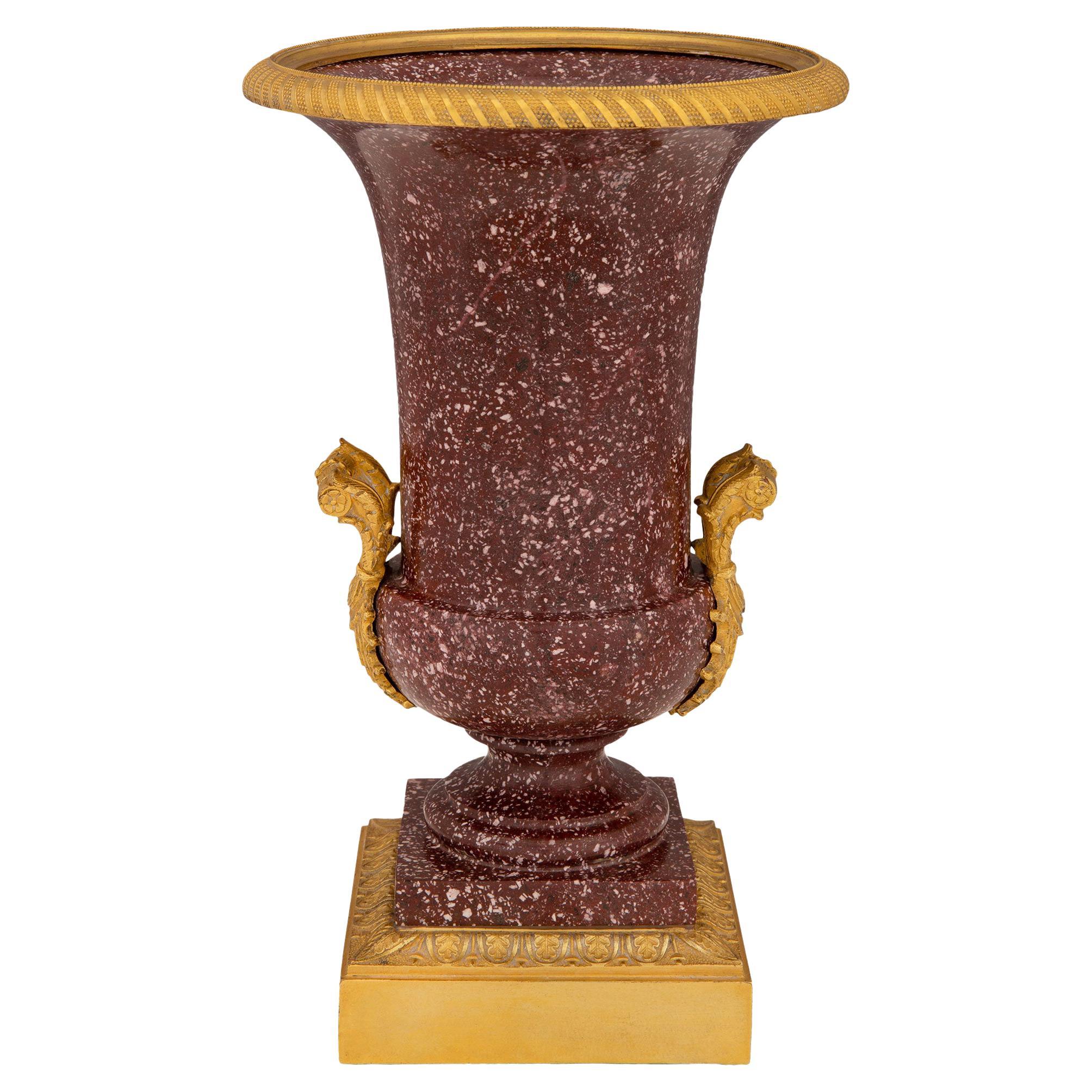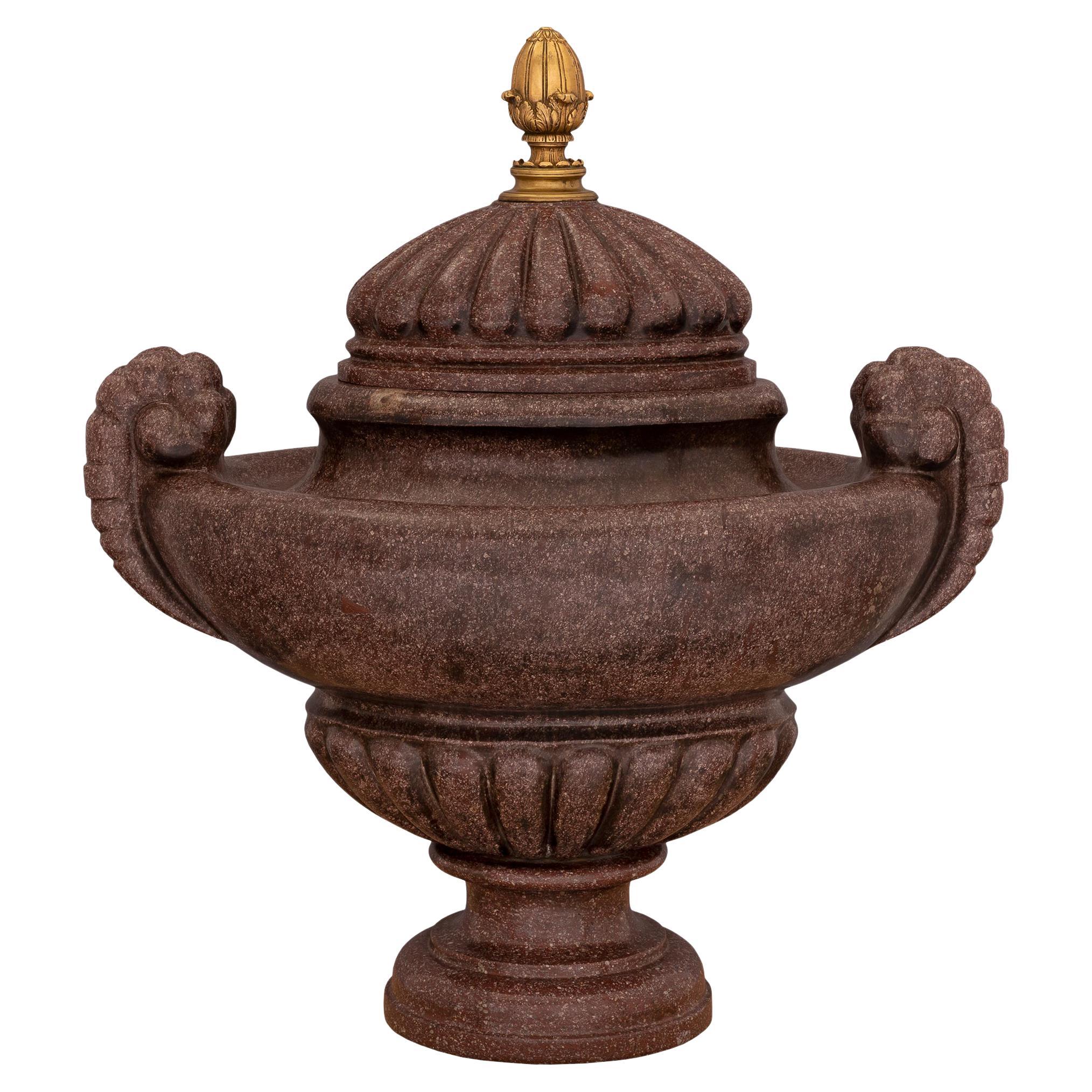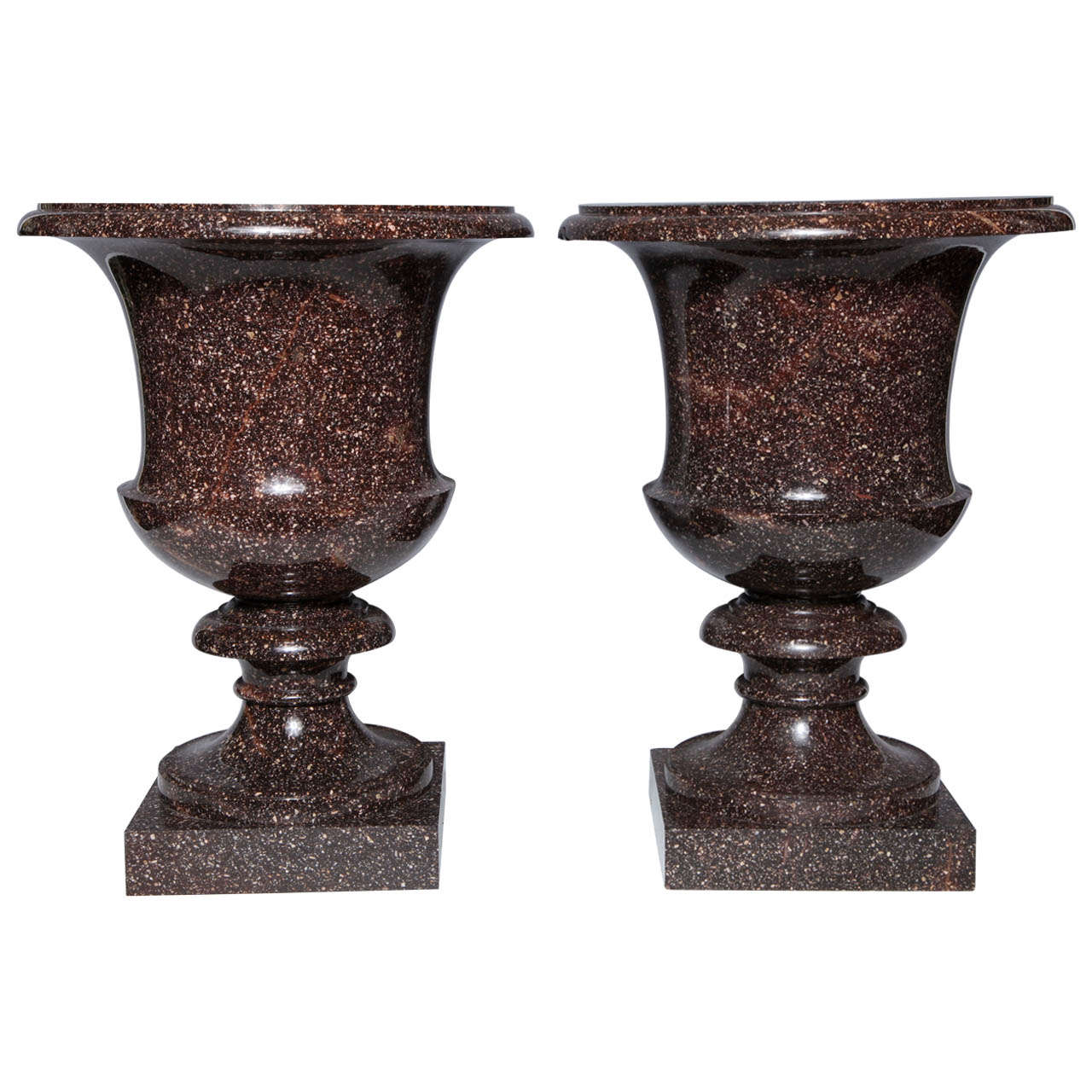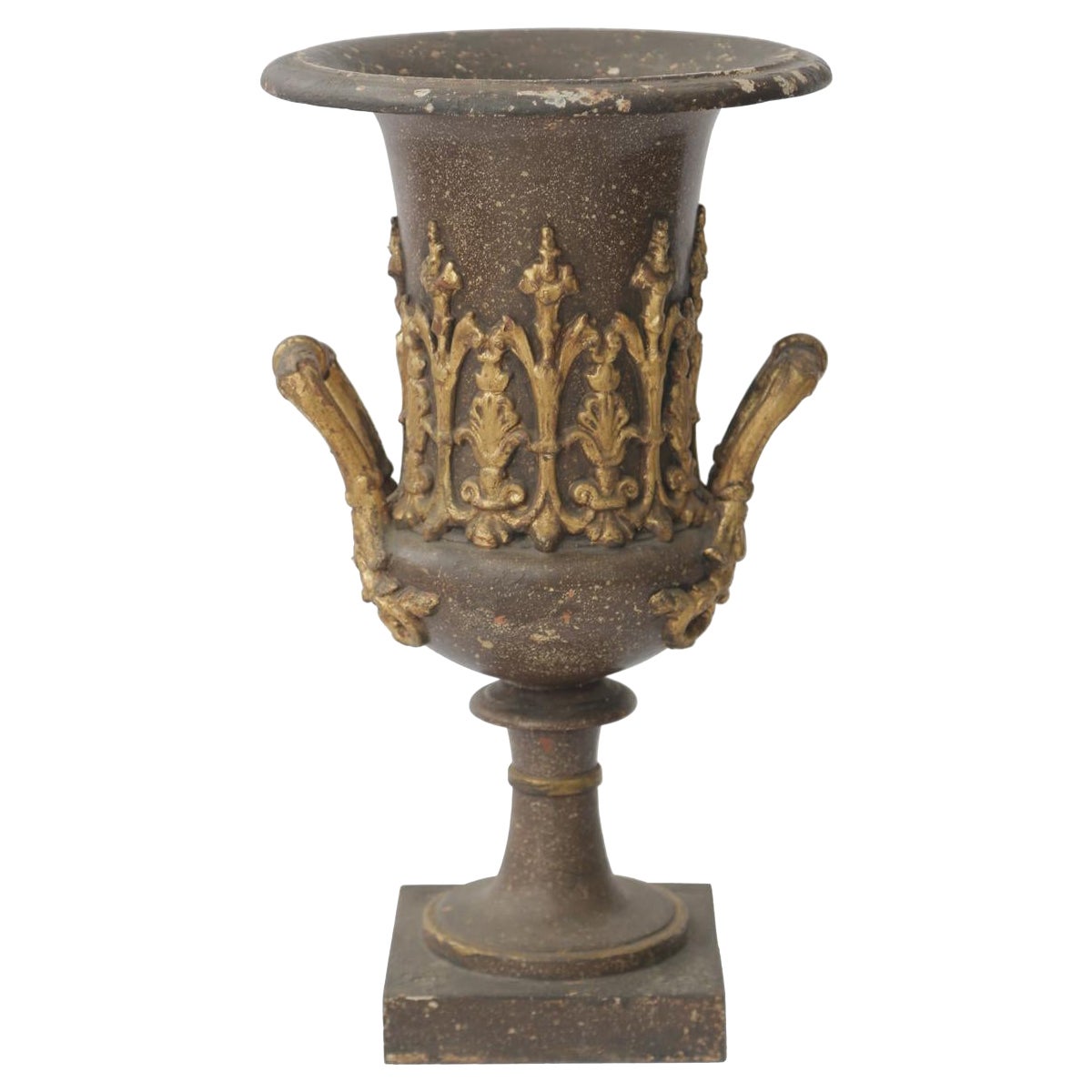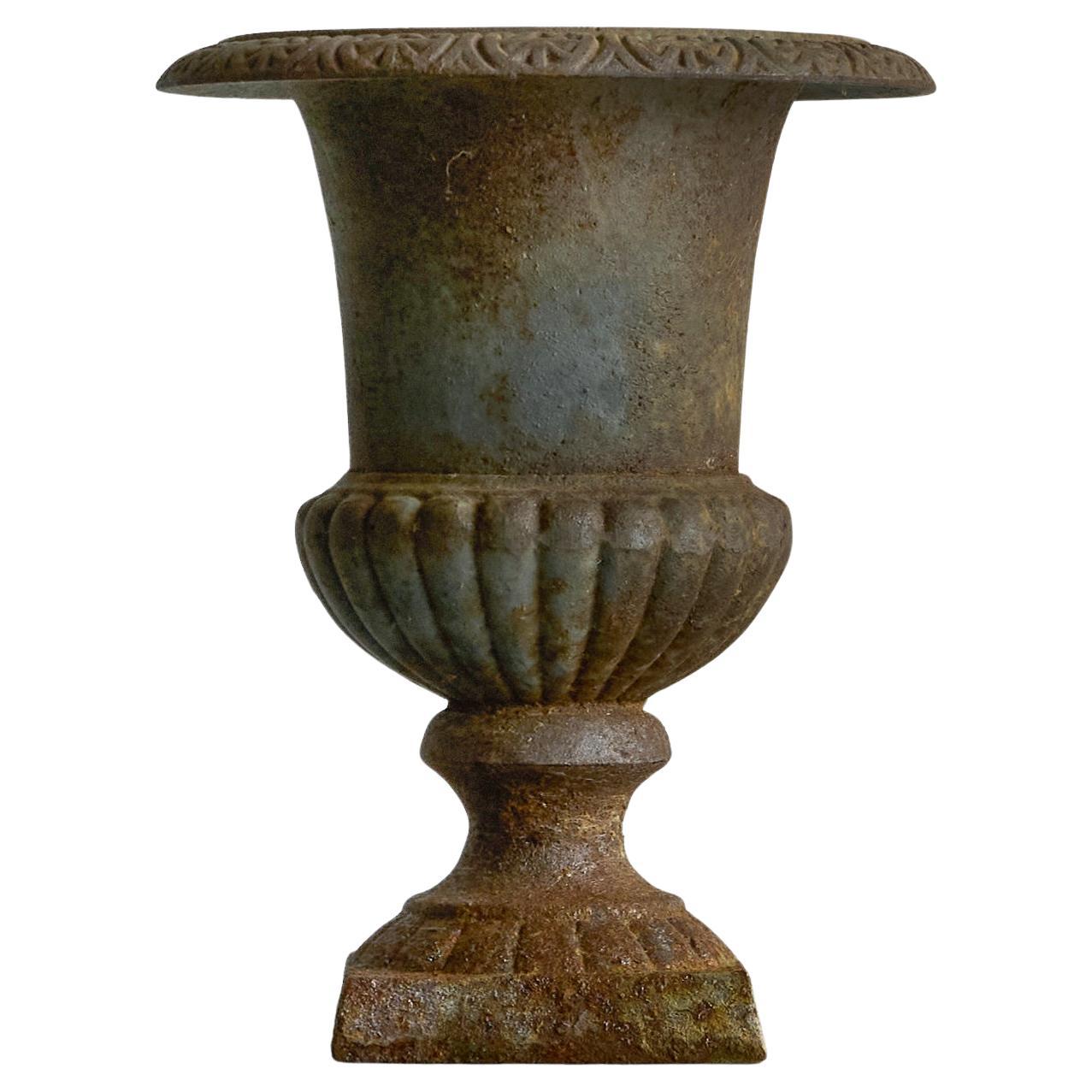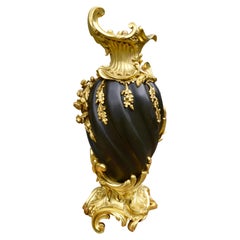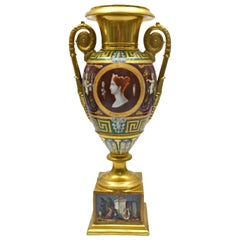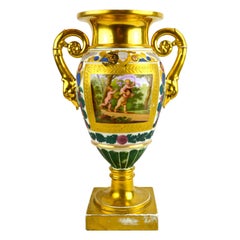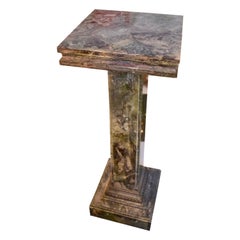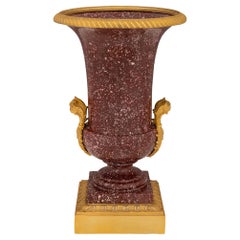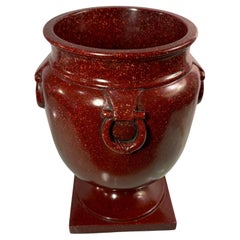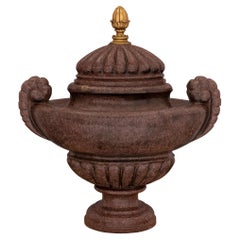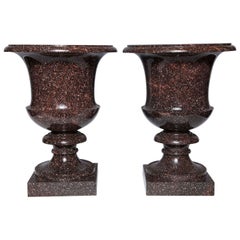Items Similar to 19th Century Neoclassical Swedish or Russian Porphyry Campana Urn Vase
Video Loading
Want more images or videos?
Request additional images or videos from the seller
1 of 10
19th Century Neoclassical Swedish or Russian Porphyry Campana Urn Vase
$10,500
£7,919.71
€9,147.35
CA$14,711.22
A$16,358.04
CHF 8,563.73
MX$199,816.47
NOK 107,611.67
SEK 101,230.34
DKK 68,284.31
About the Item
An early 19th century Swedish or Russian Porphyry campana urn vase carved in a Classic shape, likely carved by the Alvdalen factory in Sweden, the vase presently mounted on a faux green marble rectangular base,
- Dimensions:Height: 14 in (35.56 cm)Diameter: 11 in (27.94 cm)
- Style:Neoclassical (Of the Period)
- Materials and Techniques:
- Place of Origin:
- Period:
- Date of Manufacture:circa 1810
- Condition:Repaired: The vase has an early repair to the waisted socle. Photos of this repair will be provided upon request. Wear consistent with age and use.
- Seller Location:Vancouver, CA
- Reference Number:1stDibs: LU4631216168721
About the Seller
4.9
Vetted Professional Seller
Every seller passes strict standards for authenticity and reliability
Established in 1981
1stDibs seller since 2019
163 sales on 1stDibs
Typical response time: 1 hour
- ShippingRetrieving quote...Shipping from: Vancouver, Canada
- Return Policy
Authenticity Guarantee
In the unlikely event there’s an issue with an item’s authenticity, contact us within 1 year for a full refund. DetailsMoney-Back Guarantee
If your item is not as described, is damaged in transit, or does not arrive, contact us within 7 days for a full refund. Details24-Hour Cancellation
You have a 24-hour grace period in which to reconsider your purchase, with no questions asked.Vetted Professional Sellers
Our world-class sellers must adhere to strict standards for service and quality, maintaining the integrity of our listings.Price-Match Guarantee
If you find that a seller listed the same item for a lower price elsewhere, we’ll match it.Trusted Global Delivery
Our best-in-class carrier network provides specialized shipping options worldwide, including custom delivery.More From This Seller
View AllMagnificent Louis XV Style Patinated and Gilt Bronze Urn
Located in Vancouver, British Columbia
A magnificent large French XV rococo style patinated and gilt bronze urn. The fluted body of the urn, (almost ewer shaped) is of patinated bronze, the flutes inset at the top and bot...
Category
Antique Late 19th Century French Rococo Urns
Materials
Bronze
Early 19th Century Paris Porcelain Urn
Located in Vancouver, British Columbia
A museum quality early 19th century Paris porcelain urn. The twin handled vase sits on a rectangular porcelain base (modelled as part of the vase), which is decorated on all four sides with finely painted scenes titled 'Gene de Corrinte', 'Gene de Mytilene', 'Gene de Sparte', and 'Gene de Chiu' in reference to various Greek city states. The ovoid body of the vase is richly decorated with Greek key and stylized acanthus designs over and below a large gilt framed oval cameo of Athena on one side and a similar cameo on the other side bearing an undecipherable name. The overall background colour scheme of the vase is dark red/burgundy and dark emerald green, two colours which were more commonly used by the Dagoty factory in Paris than other porcelain manufacturing firms at the time. The vase is unsigned.
Note: Pierre Louis Dagoty's porcelain was characterized by the use of vivid colours and the thick application of burnished gold leaf. He borrowed from the repertoire of Neoclassical ornament but his designs also included Egyptian and Chinoiseries motifs.
Dagoty's elegant ceramics won him the patronage of Empress Joséphine. At the height of production, in 1807, he employed over a hundred workers, and exported his wares to Russia. After the fall of the First French Empire in 1814, manufacture continued under the Duchesse d'Angoulême, the only surviving child of Louis XVI and Marie-Antoinette.
Between 1816 and 1820, Dagoty worked in partnership with François Maurice Honoré. In 1817. Dagoty and Honoré received a commission from President James Monroe...
Category
Antique 1810s French Empire Urns
Materials
Porcelain
Early 19th Century Paris Porcelain Vase
By Porcelaine de Paris
Located in Vancouver, British Columbia
A Paris porcelain urn with swan’s head handles; beautifully painted frolicking cupids to the front, and matte and burnished framed musical motifs to the back. Some rubbing consistent...
Category
Antique Early 19th Century French Empire Porcelain
Materials
Porcelain
$1,920 Sale Price
20% Off
Dark Green Marble Column with Bronze Moulding
Located in Vancouver, British Columbia
A tall dark green/grey marble column; the rectangular column supports a larger tiered square marble top; the bottom of the column sits on a patinate...
Category
Antique Late 19th Century Italian Neoclassical Pedestals
Materials
Marble, Bronze
Late 19 Century Italian Neo-Classical Carved Carrara Marble Planter
By Antonio Canova
Located in Vancouver, British Columbia
This classic planter is carved from a single piece of Carrara marble. The wasted shaped pot sits on four large lions paw feet each of which are topped...
Category
Antique Late 19th Century Italian Greco Roman Planters and Jardinieres
Materials
Carrara Marble
$2,240 Sale Price
20% Off
Pompeian Style Marble Tapered Tripod Wood and Bronze Pedestal
Located in Vancouver, British Columbia
A classic painted wood marble and metal tri-pod pedestal modelled after an ancient pedestal discovered in Pompeii. Below the shaped green marble top are three metal grotesque masks w...
Category
Antique Late 19th Century Italian Classical Roman Pedestals
Materials
Marble, Metal
You May Also Like
Italian 19th Century Neoclassical Style Imperial Porphyry and Ormolu Urn
Located in West Palm Beach, FL
An outstanding and high quality Italian 19th century neo-classical st. Imperial Porphyry and ormolu urn. The exceptional solid Porphyry urn is raised by a square ormolu base with a r...
Category
Antique 19th Century Italian Neoclassical Urns
Materials
Porphyry, Ormolu
Porphyry Urn
Located in Philadelphia, PA
Porphyry Urn in rich shades of reds. Look close to see specks of white mixed in. Urn is in very nice condition with no chips or cracks. Monumental Urn that would set the stage in ...
Category
Early 20th Century Italian Neoclassical Revival Urns
Materials
Porphyry
$3,500
Italian Early 19th Century Solid Porphyry and Ormolu Urn, circa 1810
Located in West Palm Beach, FL
A magnificent and monumentally scaled Italian early 19th century solid Porphyry and ormolu urn, circa 1810. The most impressive urn is raised by a circular base with a fine stepped and mottled border. At the center is an impressive and most decorative reeded design below the smooth elegantly curved body with richly sculpted scrolled handles at each side. Above the curved neck is the removable lid also decorated with a beautiful reeded design, mottled band, and centered by a striking ormolu acorn finial. All original gilt.
Porphyry was Imperial Rome’s most prestigious stone for columns, vases, and other objects. The word “porphyry” comes from the Latin word for purple, which was the color of nobility to the Romans. Porphyry is considered the Imperial Stone of the Roman Empire. In the year 18 AD, the Roman Legionnaire Caius Cominius discovered a beautiful purple stone in the eastern desert of Egypt. It was a deep purple color with flecks of larger white crystals and was perfect for carving. This porphyry quickly became the most prestigious stone for the elite of Rome and Byzantium. For centuries the Romans quarried this treasured stone...
Category
Antique 19th Century Italian Urns
Materials
Porphyry, Ormolu
Monumental Pair of Neoclassical Period, Swedish Porphyry Campagna Shaped Vases
Located in New York, NY
A monumental pair of neoclassical period, Swedish Porphyry Campagna shaped vases, circa 1810. These magnificent handcrafted urns are carved from the uniquely Swedish Porphyry stone, rest on square plinths. Purchased from Didier Aaron in Paris by Michael Taylor.
A vase of this shape based on the Borghese vase in the Louvre is shown in a French catalogue of 1805 advertising porphyry from Elfdal in Sweden (H. Sundblom et al., Porfyr, exhibition catalogue, December 1985-February 1986, p.31). A vase of the same shape and size in Blyberg porphyry...
Category
Antique 1810s Swedish Neoclassical Vases
Materials
Porphyry
Early 19th Century Bronze Campana Urn
Located in West Palm Beach, FL
Grand Tour urn, of bronze, with a gilt and patented finish showing natural wear, having a column-snape urn-form; its down-turned bezel over its body, de...
Category
Antique Late 19th Century European Neoclassical Urns
Materials
Bronze
Beautifully Patinated Neoclassical Cast Iron Vase or Planter Late 19th Century
Located in Meer, VAN
Beautifully Patinated Neoclassical Cast Iron Vase or Planter Late 19th Century.
A very elegant and beautifully patinated cast iron vase or planter with a distinct neoclassical desig...
Category
Antique Late 19th Century European Neoclassical Vases
Materials
Iron
More Ways To Browse
Russian Carved
Green Urn
Swedish Neoclassical Furniture
Black Urn Vases
Marble Carved Urn
Neoclassical Marble Urn
Green Urn Vase
Neoclassical Black Vase
Neoclassical Marble Vases
Swedish Urn
19th Century Russian Neoclassical Furniture
Rectangular Black Vase
Green Marble Urns
Faux Porphyry
Neoclassical Black Marble Urn
Green Porphyry
Neoclassical Campana Vase
Porphyry Urn
